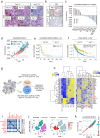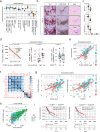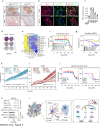MET receptor serves as a promising target in melanoma brain metastases
- PMID: 38386085
- PMCID: PMC10884227
- DOI: 10.1007/s00401-024-02694-1
MET receptor serves as a promising target in melanoma brain metastases
Erratum in
-
Correction to: MET receptor serves as a promising target in melanoma brain metastases.Acta Neuropathol. 2024 Mar 27;147(1):63. doi: 10.1007/s00401-024-02719-9. Acta Neuropathol. 2024. PMID: 38536477 Free PMC article. No abstract available.
Abstract
The development of brain metastases hallmarks disease progression in 20-40% of melanoma patients and is a serious obstacle to therapy. Understanding the processes involved in the development and maintenance of melanoma brain metastases (MBM) is critical for the discovery of novel therapeutic strategies. Here, we generated transcriptome and methylome profiles of MBM showing high or low abundance of infiltrated Iba1high tumor-associated microglia and macrophages (TAMs). Our survey identified potential prognostic markers of favorable disease course and response to immune checkpoint inhibitor (ICi) therapy, among them APBB1IP and the interferon-responsive gene ITGB7. In MBM with high ITGB7/APBB1IP levels, the accumulation of TAMs correlated significantly with the immune score. Signature-based deconvolution of MBM via single sample GSEA revealed enrichment of interferon-response and immune signatures and revealed inflammation, stress and MET receptor signaling. MET receptor phosphorylation/activation maybe elicited by inflammatory processes in brain metastatic melanoma cells via stroma cell-released HGF. We found phospho-METY1234/1235 in a subset of MBM and observed a marked response of brain metastasis-derived cell lines (BMCs) that lacked druggable BRAF mutations or developed resistance to BRAF inhibitors (BRAFi) in vivo to MET inhibitors PHA-665752 and ARQ197 (tivantinib). In summary, the activation of MET receptor in brain colonizing melanoma cells by stromal cell-released HGF may promote tumor self-maintenance and expansion and might counteract ICi therapy. Therefore, therapeutic targeting of MET possibly serves as a promising strategy to control intracranial progressive disease and improve patient survival.
Keywords: Brain metastasis; ITGB7; Interferon signaling; MET receptor; Melanoma; TAMs.
© 2024. The Author(s).
Conflict of interest statement
The authors declare no conflicting interests.
Figures






References
Publication types
MeSH terms
Substances
LinkOut - more resources
Full Text Sources
Medical
Research Materials
Miscellaneous

